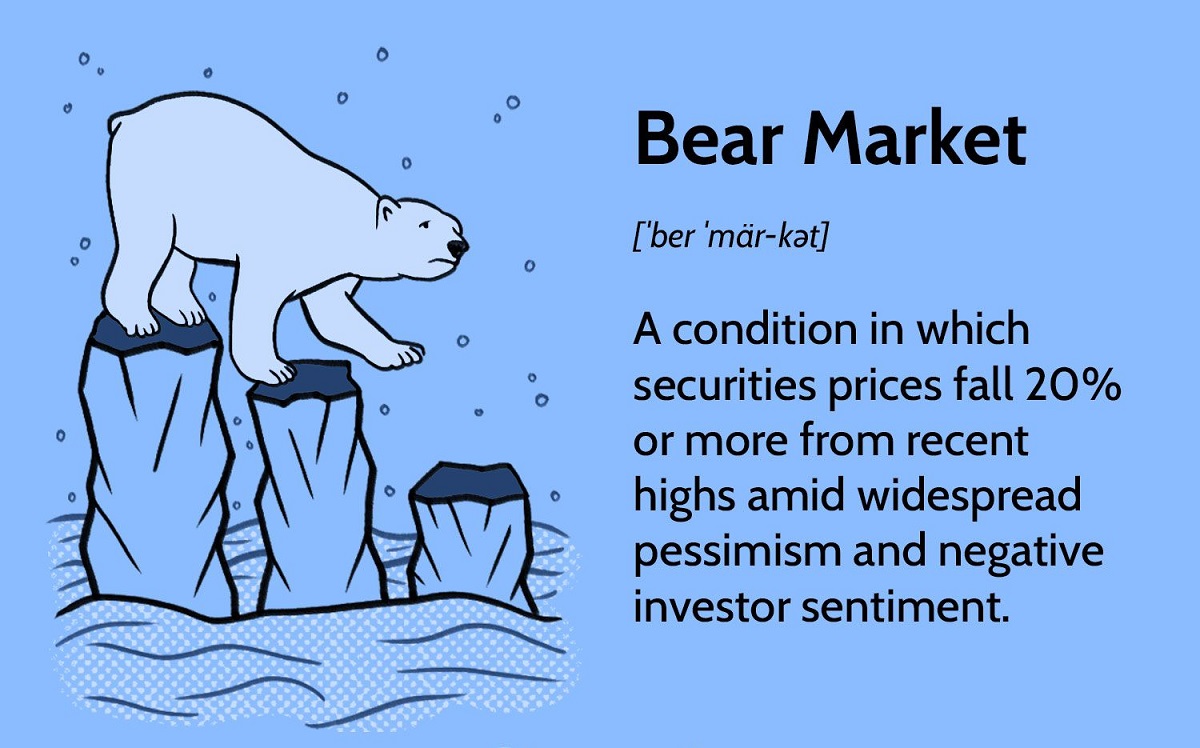Emotional Reactivity and Fear
During a bear market, it is common for many people to sell their investments due to emotional reactivity and fear. This emotional response is often driven by the instinct to protect oneself from potential losses and the apprehension of further market declines.
Emotions, such as fear and panic, can cloud rational judgment and lead to impulsive decision-making. When investors witness the decline in stock prices and the overall negative sentiment in the market, it is natural to feel anxious and concerned about the future of their investments.
Psychologically, people tend to be more sensitive to losses than gains. This phenomenon, known as loss aversion, causes individuals to experience a stronger negative emotional response to losses compared to the positive emotional response to equivalent gains. As a result, during a bear market, the fear of sustaining additional losses often outweighs the desire to potentially benefit from a market recovery.
Additionally, a lack of confidence in the market can contribute to the tendency to sell investments. When there are widespread economic uncertainties or negative news impacting the market, investors may lose faith in the ability of their investments to generate returns. This loss of confidence further amplifies the fear-driven decision to sell.
Furthermore, the fear of market timing and the desire to predict the bottom of the market often influence individuals to sell their investments. Many investors attempt to time the market by selling when they believe the market has reached its lowest point and plan to buy back in at a later time. However, accurately predicting the timing of market bottoms is extremely challenging, if not impossible, even for seasoned professionals.
Another factor contributing to the selling pressure during a bear market is the herd mentality. When investors observe others selling their investments, they may feel compelled to follow suit in order to avoid being left behind or to align with the general sentiment. This collective behavior can further exacerbate market declines.
Lastly, the failure to properly diversify and allocate assets can make investors more susceptible to fear-driven reactions. If an individual’s portfolio is concentrated in a particular sector or company, and that sector or company experiences significant declines, it can amplify the fear of losing a substantial portion of their investment.
Lack of Confidence in the Market
One of the primary reasons why many people sell their investments during a bear market is due to a lack of confidence in the market itself. When the market experiences a downturn, it can erode investors’ trust and belief in the stability and profitability of their investments.
During a bear market, negative economic indicators, geopolitical tensions, and other factors can shake investor confidence. This lack of confidence stems from the fear that the downward trend in the market may continue or worsen, leading to further losses in their investment portfolios.
Investors who lack confidence in the market may feel uncertain about the prospects for future returns. They may question whether the economy will recover, if there will be sufficient demand for goods and services, and if companies will be able to weather the storm and maintain profitability.
Moreover, media coverage during a bear market often amplifies negative sentiment and can fuel the lack of confidence in the market. News outlets tend to focus on the negative impacts of the downturn, sensationalizing market declines and predicting further doom and gloom. This saturation of negative information can intensify investors’ doubts and lead them to believe that selling their investments is the best course of action.
Furthermore, novice investors or those with limited investment experience may lack the knowledge and understanding of the market dynamics during a bear market. They may not have the confidence to hold onto their investments and ride out the storm. The fear of losing their hard-earned money overtakes their rational thinking, pushing them to sell and exit the market.
Additionally, individuals who have experienced previous bear markets and sustained significant losses may become more risk-averse. The past negative experiences can leave a lasting impact on their confidence in the market, causing them to sell their investments at the first sign of trouble in order to protect their remaining capital.
It is important to note, however, that lack of confidence in the market and selling investments during a bear market can have detrimental effects on long-term investment performance. History has shown that markets tend to recover and provide positive returns over the long run. Therefore, it is crucial for investors to carefully evaluate their decisions based on comprehensive research and analysis rather than solely relying on their confidence levels during periods of market volatility.
Loss Aversion
Loss aversion is a psychological bias that can significantly impact investment decision-making, especially during a bear market. It refers to the tendency of individuals to feel the pain of losses more keenly than the pleasure resulting from equivalent gains.
During a bear market, as stock prices decline and investment portfolios shrink, investors can become overly focused on potential losses. The fear of incurring further losses can trigger a strong emotional response, leading to a heightened sense of urgency to sell their investments.
This aversion to losses stems from the desire to protect one’s capital and avoid the regrets and negative emotions associated with poor investment performance. Loss aversion can lead investors to adopt a conservative approach and prioritize capital preservation, often at the expense of maximizing potential gains.
Investors who are strongly loss-averse may have a reluctance to sell their investments at a loss, hoping for a market rebound that will bring their holdings back to breakeven or profitability. This behavior, known as “holding on to losers,” is driven by the fear of realizing and accepting the losses.
Loss aversion can also manifest in investors trying to cut their losses quickly, selling their investments as soon as they experience a decline in value. They may feel that by doing so, they are taking decisive action to prevent further losses, even if it means relinquishing the potential for future gains.
Furthermore, loss aversion can lead to a bias towards conservative investments and asset allocation. Investors may opt for lower-risk options, such as bonds or cash, to mitigate the perceived risk of loss. This cautious approach might provide a sense of security during a bear market but can limit the potential for long-term growth and higher returns.
It is important for investors to be aware of the influence of loss aversion on their decision-making process. While it is natural to feel protective of investments in turbulent times, it is crucial to maintain a rational and balanced approach. Taking the time to evaluate the long-term prospects of investments, seeking professional advice, and considering the potential gains alongside the potential losses can help investors make more informed decisions.
By understanding and managing the impact of loss aversion, investors can better navigate the challenges of a bear market and avoid making hasty or emotionally-driven decisions that may negatively impact their investment portfolios.
Pressure to Cut Losses and Protect Capital
During a bear market, investors often face external and internal pressures to cut losses and protect their capital. This pressure stems from various factors and can influence their decision-making process.
Externally, there may be societal and peer pressure to sell investments and cut losses. In a bear market, it is common to see news articles, financial pundits, and even friends or family members advocating for selling investments to limit further losses. This external pressure can create a sense of urgency and fear of missing out on an opportunity to protect one’s capital.
Financial institutions and brokerage firms may also heighten the pressure by providing constant reminders, updates, and alerts about the declining market. They may utilize fear-inducing marketing tactics to persuade investors to take immediate action, such as selling their investments.
Internally, individuals may feel the pressure to cut losses due to their own anxieties and emotional reactions to market declines. The fear of losing a significant portion of their investment can be overwhelming, leading to a strong desire to protect the remaining capital. This internal pressure can cloud rational judgment, making it difficult to make well-informed decisions.
Investors may also feel pressured to cut losses in an attempt to regain a sense of control over their investments. Selling allows them to take proactive action and mitigate further potential losses. This need for control can be driven by the uncertainty and volatility of the bear market, making individuals anxious about the future performance of their investments.
Furthermore, investors may face pressure from themselves to avoid the emotional pain and regret associated with holding onto declining investments. Selling investments at a loss can provide a sense of relief and prevent feelings of remorse or self-blame for not taking action sooner.
While it is important to protect capital during a bear market, succumbing to the pressure to cut losses without careful consideration can have long-term consequences. Selling investments solely based on short-term market movements may result in missing out on potential gains when the market eventually recovers.
Investors should strive to strike a balance between protecting capital and maintaining a long-term investment strategy. This may involve a thorough assessment of individual investment goals, risk tolerance, and a comprehensive evaluation of the underlying fundamentals of the investments in question.
It is crucial to approach investing with a long-term perspective and avoid making impulsive decisions driven by external or internal pressures. By keeping emotions in check and making decisions based on careful analysis, investors can navigate the pressures to cut losses and protect capital more effectively.
Market Timing and Trying to Predict the Bottom
One common factor that leads many people to sell their investments during a bear market is the temptation to engage in market timing and predict the bottom of the market. Market timing refers to the strategy of buying or selling investments based on attempting to forecast future market movements.
During a bear market, investors may be lured into selling their investments with the hope of avoiding further losses. They may believe that by selling at the right time, just before the market reaches its lowest point, they can protect their capital and potentially buy back in at a later stage when prices are lower.
However, accurately timing the market and predicting the exact bottom is an incredibly challenging task. Even experienced professionals often struggle with this endeavor. The market can be highly unpredictable, influenced by a multitude of factors including economic data, geopolitical events, and investor sentiment.
Attempting to time the market usually requires making decisions based on short-term market fluctuations and reacting to immediate news or events. This can lead to impulsive and emotionally driven decisions that may not align with long-term investment goals or sound investment principles.
Moreover, trying to predict the bottom of the market can lead to a phenomenon known as “paralysis by analysis.” Investors may become consumed with analyzing charts, indicators, and economic data, constantly second-guessing their decisions and missing out on potential market recoveries.
Selling investments based on market timing often requires two successful predictions: when to sell and when to buy back in. Even if an investor successfully sells prior to a market decline, they still need to accurately predict when the market will hit bottom and be positioned to buy back in at that exact moment.
Market timing involves not only knowing when to sell and buy but also overcoming transaction costs, which can erode potential gains. These costs may include brokerage fees, taxes, and the risk of missing out on dividend payments or capital appreciation during the waiting period.
Investors who solely focus on market timing may find themselves caught in a perpetual cycle of buying and selling, often resulting in reduced returns compared to a disciplined long-term investment strategy. They may miss out on the potential for capital appreciation during market recoveries, which historically have eventually followed bear markets.
Instead of engaging in market timing, it is generally advisable for investors to adopt a more disciplined and systematic approach. This involves creating a well-diversified investment portfolio aligned with their risk tolerance and time horizon, and sticking to an appropriate asset allocation strategy regardless of short-term market fluctuations.
By staying invested and maintaining a long-term perspective, investors are more likely to benefit from the potential growth and recovery of the market over time. Attempting to time the market often leads to unnecessary stress, increased costs, and missed investment opportunities.
Following the Herd Mentality
During a bear market, the herd mentality can exert a powerful influence on investors, leading many to sell their investments. The herd mentality refers to the tendency of individuals to conform to the actions and decisions of the majority, often driven by the fear of missing out or the desire to avoid potential losses.
When investors witness others selling their investments en masse, it can create a sense of panic and fear of being left behind. This fear can push individuals to follow the crowd and sell their investments, even if it may not be the most rational decision based on their own investment strategy or long-term goals.
The herd mentality is fueled by the belief that others have access to superior information or insights, leading to a fear of being the “last one out” or “left holding the bag.” Investors may believe that if everyone else is selling, there must be a valid reason to do so, even if they may not fully understand or agree with that reasoning.
This herd behavior can exacerbate market declines as the increased selling pressure pushes prices lower, creating a self-reinforcing cycle. This downward spiral can be driven more by fear and emotional reactions rather than a careful analysis of the underlying fundamentals of the investments being sold.
Furthermore, the prevalence of social media and instant information dissemination has amplified the herd mentality in recent years. Investors can quickly see and react to the actions of others in real-time, leading to a faster and more pronounced herd effect.
However, blindly following the herd can be detrimental to investment performance. Selling purely based on herd behavior disregards an individual’s unique investment goals, risk tolerance, and financial situation. It can result in missed opportunities for potential market rebounds and long-term growth.
Investors should approach the herd mentality with caution and take time to evaluate their decisions independently. It is essential to distinguish between following the crowd and making informed decisions based on thorough research and analysis.
While it can be helpful to consider market trends and sentiments, blindly following the herd can lead to a loss of individuality and personal responsibility for investment decisions. Investors should strive to develop a disciplined and independent mindset, focusing on long-term strategies rather than getting caught up in short-term market fluctuations.
By maintaining a balanced and rational approach, investors can avoid making hasty decisions driven solely by the herd mentality. They can insulate themselves from the emotional pressure of the crowd and potentially capitalize on investment opportunities that may arise during a bear market.
Failure to Diversify and Allocate Assets Properly
One significant reason why many people sell their investments during a bear market is the failure to diversify and allocate their assets properly. Diversification refers to spreading investments across different asset classes, industries, and geographic regions to reduce risk. Asset allocation involves determining the percentage of investments allocated to different asset classes based on an individual’s risk tolerance and investment objectives.
During a bear market, investors who have not properly diversified their portfolios may experience significant losses concentrated in specific sectors or companies. This lack of diversification leaves them more vulnerable to the downturns of particular industries or economic cycles.
Moreover, inadequate asset allocation can exacerbate the impact of a bear market. If an investor has allocated a disproportionate amount of their portfolio to high-risk investments, such as stocks, they may face higher losses during a market decline. Failing to allocate a sufficient portion of the portfolio to more stable assets, such as bonds or cash, can limit the investor’s ability to cushion the impact of market downturns.
Investors who lack proper diversification and asset allocation may panic during a bear market due to the concentrated losses in their portfolios. The fear of further declines and the desire to minimize risk can propel them to sell their investments hastily, without considering the potential for recovery or long-term growth.
Additionally, inadequate diversification and asset allocation can hinder the potential for future returns. By not taking advantage of a wide range of investment opportunities, investors may miss out on areas of the market that could potentially perform well, even during a bear market.
To address this issue, investors should adopt a strategic approach to diversify and allocate their assets properly. This involves assessing their risk tolerance, investment goals, and time horizon. Seeking professional advice can also be beneficial in developing a personalized investment strategy that aligns with these factors.
Diversification can be achieved through a mix of asset classes, such as stocks, bonds, real estate, and commodities. Within each asset class, further diversification can be achieved by investing in different industries or sectors and considering exposure to both domestic and international markets.
Asset allocation should be based on an investor’s risk profile. By allocating investments across multiple asset classes, investors can potentially reduce the impact of market downturns and increase the likelihood of capturing returns from different sources.
Regular monitoring and periodic rebalancing of the portfolio is essential to maintain proper diversification and asset allocation. As market conditions change, so too should the composition of the investment portfolio. This will help ensure that investments remain aligned with the investor’s goals and risk tolerance.
By diversifying and allocating assets properly, investors can minimize the impact of a bear market and improve their chances of achieving long-term investment success. Having a well-diversified portfolio provides a more stable foundation and helps investors weather the storms of market fluctuations.

























